
Grevillea vestita is a species of flowering plant in the family Proteaceae and is endemic to the southwest of Western Australia. It is an erect, spreading, prickly shrub with lobed leaves, the number and arrangement of lobes depending on subspecies, and more or less spherical to dome-shaped clusters of hairy, white to cream-coloured flowers sometimes tinged with pink.

Grevillea levis is a species of flowering plant in the family Proteaceae and is endemic to the west of Western Australia. It is a dense shrub with divided leaves, the end lobes linear and sharply pointed, and clusters of white to cream-coloured flowers, sometimes flushed with pink.

Grevillea barklyana, also known as gully grevillea or large-leaf grevillea, is a species of flowering plant in the family Proteaceae and is endemic to Western Gippsland in Victoria, Australia. It is an erect shrub or small tree, with mostly pinnatifid leaves with two to eleven lobes, and whitish pink to fawn flowers.

Grevillea paniculata, commonly known as kerosene bush, is a species of flowering plant in the family Proteaceae and is endemic to the south-west of Western Australia. It is a dense shrub with divided leaves, the lobes linear, and more or less spherical clusters of white to cream-coloured flowers.
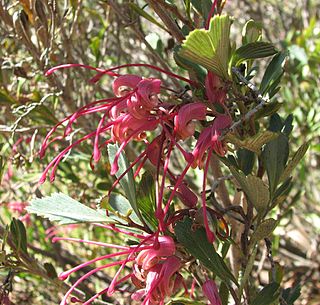
Grevillea pectinata, commonly known as comb-leaf grevillea, is a species of flowering plant in the family Proteaceae and is endemic to the south of Western Australia. It is a spreading shrub with divided, comb-like leaves and mauve-pink to red and cream-coloured to yellow flowers with a red to deep pink style.
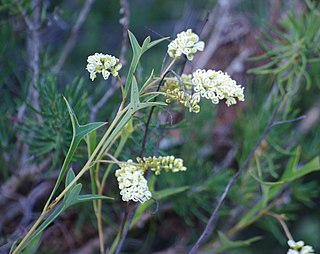
Grevillea synapheae, commonly known as catkin grevillea, is species of flowering plant in the family Proteaceae and is endemic to the southwest of Western Australia. It is a prostrate to erect shrub usually with divided leaves with 3 to 7 triangular to more or less linear lobes, and clusters of white to creamy yellow flowers.

Grevillea diversifolia, the variable-leaved grevillea, is a species of flowering plant in the family Proteaceae and is endemic to the south-west of Western Australia. It is an erect to prostrate shrub with simple or divided leaves and groups white to cream-coloured flowers with a dull red style.
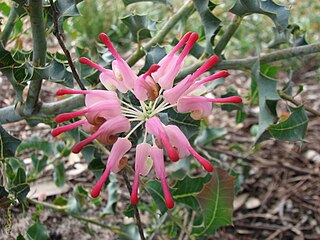
Grevillea insignis, commonly known as wax grevillea, is a species of flowering plant in the family Proteaceae and is endemic to the south-west of Western Australia. It is an erect, bushy shrub with more or less oblong leaves with seven to seventeen sharply-pointed, triangular teeth, and more or less spherical or cylindrical clusters of cream-coloured flowers ageing to pink.

Kunzea muelleri, commonly known as yellow kunzea, is a flowering plant in the myrtle family, Myrtaceae and is endemic to mountainous areas of south-eastern Australia. It is a low-growing, spreading shrub with linear leaves and small groups of pale yellow, stalkless flowers that appear in the summer.
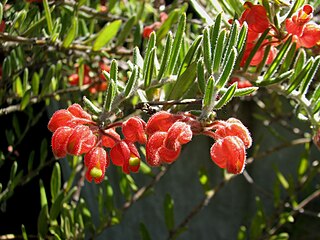
Grevillea saccata, commonly known as pouched grevillea, is a species of flowering plant in the family Proteaceae and is endemic to the south-west of Western Australia. It is a low, spreading to diffuse, scrambling or trailing shrub with linear to oblong or egg-shaped leaves with the narrower end towards the base, and small clusters of red and orange flowers with a lime-green style.
Grevillea nematophylla, commonly known as water bush or silver-leaved water bush, is a species of flowering plant in the family Proteaceae and is endemic to Australia. It is shrub or small tree with simple or pinnatisect leaves, the leaves or lobes linear, and branched, cylindrical clusters of cream-coloured flowers.

Seringia integrifolia, commonly known as common firebush, is a species of flowering plant in the family Malvaceae and endemic to the south-west of Western Australia. It is a compact shrub, its new growth densely covered with star-shaped hairs, and has mostly narrowly leaves and many deep blue to purple flowers arranged in groups of 4 to 10.

Grevillea anethifolia, commonly known as spiny cream spider flower, is a species of flowering plant in the family Proteaceae and is endemic to continental Australia. It is an erect shrub with hairy branchlets, lobed leaves, the lobes sharply pointed, and white to pale yellow or cream-coloured flowers.

Grevillea amplexans is a species of flowering plant in the family Proteaceae and is endemic to the Mid West region of Western Australia. It is a spreading shrub with arching branches, stem-clasping, sharply-pointed, lobed or toothed leaves and white to cream-coloured flowers.

Grevillea commutata is a species of flowering plant in the family Proteaceae and is endemic to the west of Western Australia. It is a spreading, open to dense shrub with egg-shaped leaves with the narrower end towards the base, and white, cream-coloured, and pinkish-green flowers.

Grevillea leiophylla, commonly known as wallum grevillea, or dwarf spider oak, is a species of flowering plant in the family Proteaceae and is endemic to Queensland. It is a weakly erect to low-lying shrub with narrowly oblong to egg-shaped or more or less linear leaves, and clusters of pale to deep pink flowers.

Petrophile semifurcata is a species of flowering plant in the family Proteaceae and is endemic to an area near the west coast of Western Australia. It is an erect, bushy shrub with sharply-pointed, needle-shaped, sometimes lobed leaves and oval heads of silky-hairy, whitish, lemon-yellow or cream-coloured flowers.
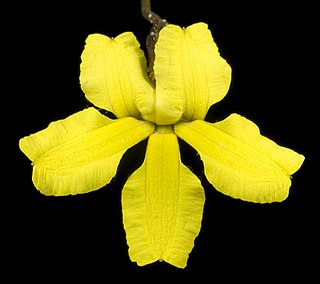
Goodenia concinna is a species of flowering plant in the family Goodeniaceae and endemic to coastal area of southern Western Australia. It is a perennial, herb with linear to lance-shaped leaves, and racemes of yellow or cream-coloured flowers.

Bossiaea dentata is a species of flowering plant in the family Fabaceae and is endemic to the south of Western Australia. It is an erect, sometimes prostrate shrub with variably-shaped leaves and greenish-yellow or pink to burgundy-coloured flowers.

Spyridium bifidum, commonly known as forked spyridium, is a species of flowering plant in the family Rhamnaceae and is endemic to South Australia. It is an erect shrub with densely softly-hairy young stems, wedge-shaped to linear leaves sometimes with a two-lobed tip, and densely woolly heads of white-velvety flowers.



















